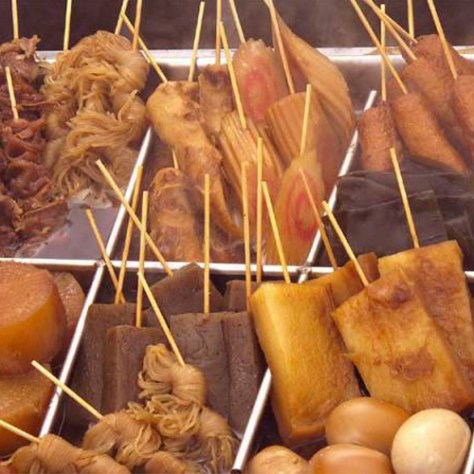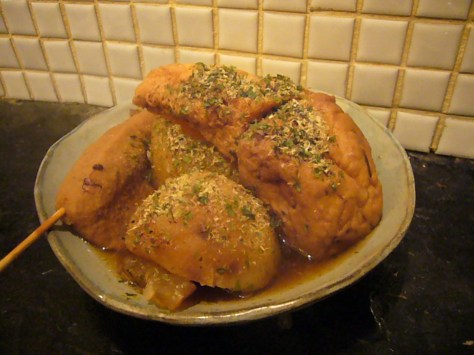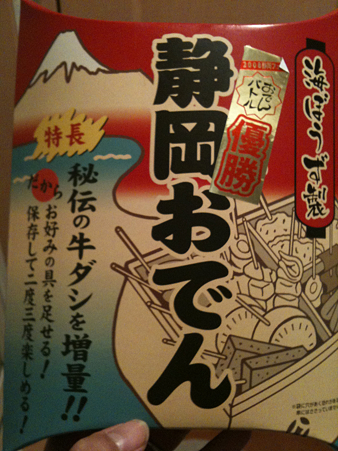Dark Shizuoka Oden
When winter seems bent on holding us company and taking a sadistic pleasure listening to our moans, everything to warm up our bodies is welcome.
The Japanese have come up with the ideal solution: Oden (おでん)!
The beauty of it is that it is sustaining food, quite cheap fare by this country standards and very comforting.
For a closer look!
Oden has a long history. It can be traced back to Edo times when it was called Kanto-daki/関東煮, meaning Kanto region stew. At the time it was mainly made with strong soy sauce and soup stock extracted from a combination of konbu/seaweed, whale meat and beef tendons.
The whalemeat has disappeared but the broth is still made with the same soy sauce, seaweed and beef tendons in the east of Japan.
On the other hand, many contend that Oden was originally what is now commonly called misodengaku or simply dengaku. Take your pick!
Dark Shizuoka Oden again!
It can be found all over the Japanese archipelago all year round (not only in winter!) in many guises and many trends, although it can roughly be divided into three categories:
-Simmered in a light broth most popular in the Kansai Region/Western Japan.
-Served with Miso, notably in the Nagoya area.
-Cooked in a dark soup in the Kanto Region/Eastern Japan.
Many people will argue that each region, or even city, has its own original brand of oden, and they might be right as ingredients greatly vary although the three above methods prevail.
The Japanese are so entrenched in their fondness of oden that regular TV shows extol the virtues of their national comfort food with “talents” recruited in each Prefecture on a single stage!
Even darker Shizuoka Oden!
But wherever you go, look forward to sampling common ingredients:
-Eggs: they are first boiled before being skewered and left in the broth. Actually skewering oden is far from being universal. But the sticks attached to them will certainly help you when choose them out of impossibly dark soup in Shizuoka!
-Potatoes: popular almost everywhere, they are seemingly a favorite of expats.
Now, have you ever wondered how potatoes do not break up being left for ages in hot broth and roughly manipulated around?
The potatoes are first boiled to about 80% and then plunged into ice water or immediately locked in a fridge. Do not be worried when the local odenyasan/oden shop owner opens his/her fridge for more potatoes to add into the broth, but choose them with a nice color when fishing them out!
-Daikon, or Japanese long radish: these are also prepared like potatoes to ensure they do not break.
-Konnyaku: Devil’s Tongue tuber jelly: some odenya will serve it in thick triangular or rectangular pieces or as ito konnyaku/konnyaku vermicelli.
-Tofu or bean curd: it is usually of the harder kind and seared first before plunging them in the broth.
Out of the pot!
Oden is often sold from food carts, and most Japanese convenience stores now have simmering oden pots in winter containing different kinds of oden sold, with single-ingredient varieties as cheap as 50 yen.
You can of course buy any ingredients of your liking, cook them in your preferred broth at home with hot Japanese mustard and some beer or (hot) sake like many do in Japanese households.
As served in Odenya!
But the best way to enjoy oden and discover their varieties is to eat outside with a mind to have a (few) drinks on your own or with special company!
Shizuoka Aoba Koen Oden Alley!
Now Shizuoka Oden has probably become the most famous (maybe notorious?) variety in Japan.
In an era when so-called B-Gourmet, or even C-Gourmet (Japanese expressions!) have become a regular feature on TV and other media, Shizuoka is not following the norms.
Odenya there serve a dark (and even black to visitors from Kansai who favour a light dashi!) broth flavored with beef stock and strong soy sauce. Moreover all ingredients are skewered, that for “true” Shizuoka Oden. Another peculiarity is that they are served with a powdery mixture of dried ground fish (sardine, mackerel or bonito shavings) and aonori (edible seaweed). More often customers will be handed plates and allowed to take out their preferred morsels and spoon out some oden seasoning powder they will liberally sprinkle over their food. On top of this the same customers will add hot Japanese mustard from one of the pots on the table or counter.
Shizuoka Oden Pack
Visitors from other regions might entertain some reservations when witnessing Shizuokans choose with utmost care the oldest pieces, some of them eggs which have become a solid burnt brown on the outside or triangular pieces of fish paste that no one else would be able to recognize as such!
Now, if you have the occasion to stop and visit Shizuoka City (other areas in the prefecture do also have their own peculiar tidbits on offer like beef lungs in Gotenba!), go to Aoba Koen Park Street.
The whole park used to be lined with yatai/food stands serving oden and drinks from as early as 3 o’clock in the afternoon (some still do) until the wee hours of the morning.
But a new hygiene law in the 1960’s forced them into moving inside alleys and corridors between other buildings where the became Aoba Oden Alleys.
They totalled at least 36 shops at the present, all with their specialties and famous characters. Actually an official pamphlet lists more than 80 specialized odenya and more than 300 izakayas serving real Shizuoka Oden!
Shizuoka Oden Festival Poster.
Every year a Shizuoka Oden Festival is held in mid-February in the Aoba Koen and Gofuku-cho area for the pleasure all, adults and children, day or night, Japanese or expats!
The perfect comfort food with superlative Shizuoka Sake!
For people who do not have the time to visit Shizuoka, oden are sold in tins, cans, and bags on the Shizuoka JR Station platforms!









One thought on “Oden: A Shizuoka Specialty!”